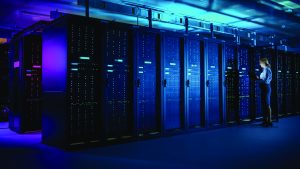Supercomputing Demands New Protocols and Thinking for Data Centers
The power and communication needs required for high-performance computers far surpass those of a standard computer, creating substantial loads and challenges for facilities professionals as high performance computing systems become increasingly mainstream in data center operations. Although the load will increase, the use of high performance computers could help improve data center efficiency.
While typical computers require 120 volts to operate, high performance computers up the ante to 480 volts. Because supercomputers don’t need power distribution units (PDUs) to convert the system’s output of 480 volts to 208/120 volts, they instead run off of a 3-phase, 480-volt direct power line. This set-up keeps wires small and power maximized, something that gives facilities professionals a proverbial leg-up on energy efficiency. Because PDUs have efficiency of 95 percent, switching to a direct supply will automatically increase efficiency within a facility.
It might seem paradoxical, but the large loads associated with high performance computers, while increasing the amount of power required, actually can lower a facility’s power usage effectiveness (PUE) and boost efficiency. The load from high performance computers can push the UPS system to capacity, which in turn makes it operate more efficiently.
Facilities professionals must examine the communications requirements of high performance computers and also take into consideration the immense amount of bandwidth these supercomputers consume. One solution is a communications protocol called InfiniBand, which uses what’s known as “switched-fabric topology” to operate. This includes connectors for speed and redundancy, as well as devices for input and output, ultimately delivering up to 2.5 gigabytes of data flow per second. The protocol, which isn’t exclusive to the high performance computing market, also can support up to 64,000 addressable devices and is competition to 10-gigabit Ethernet systems, both of which deliver more robust communications for data centers.
Click here to learn more about the power and communication needs of supercomputers.


